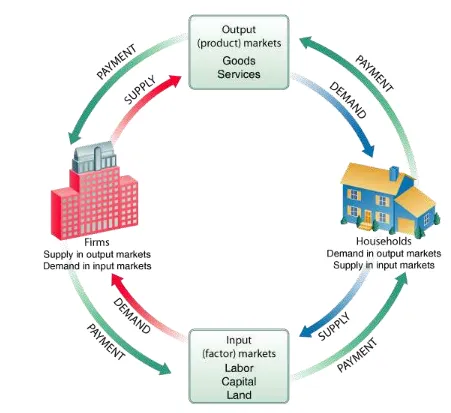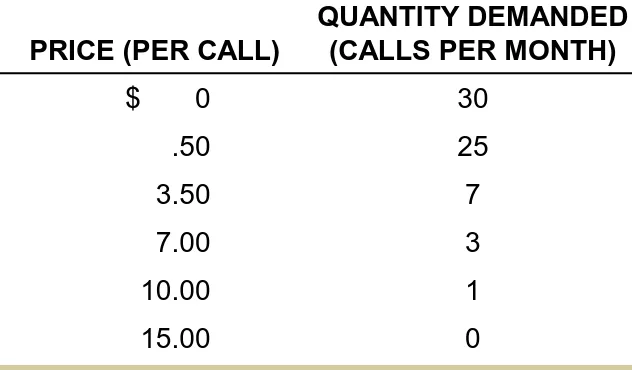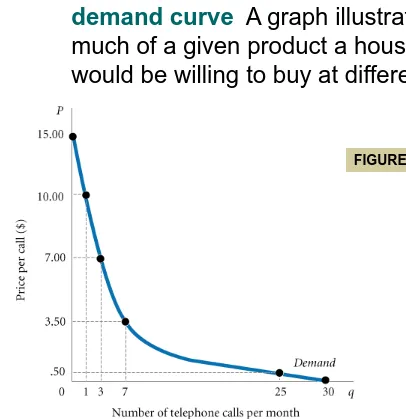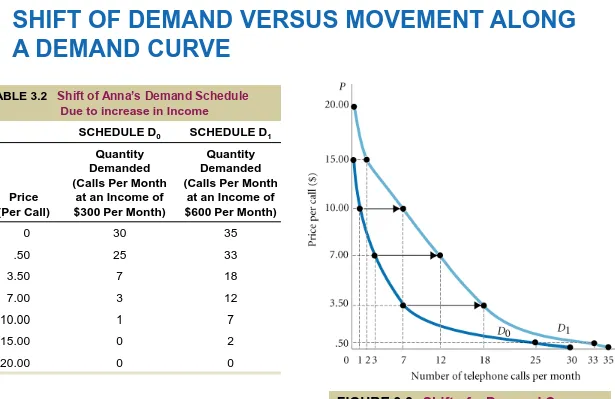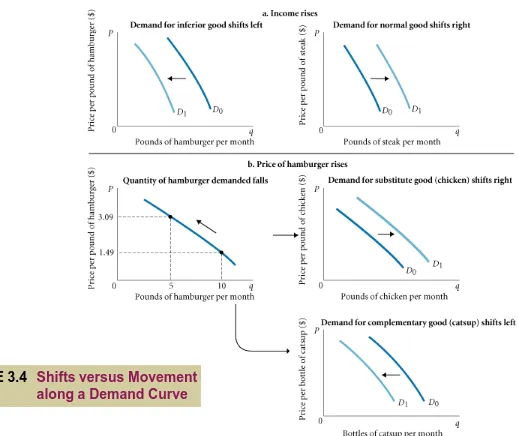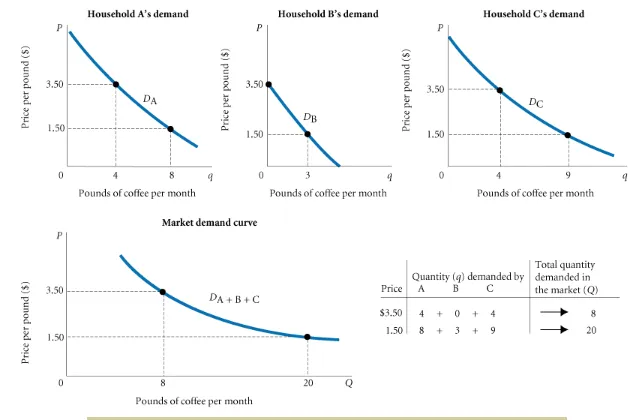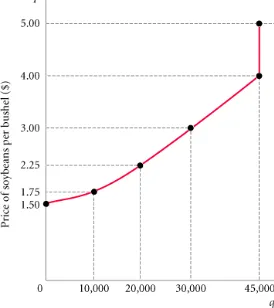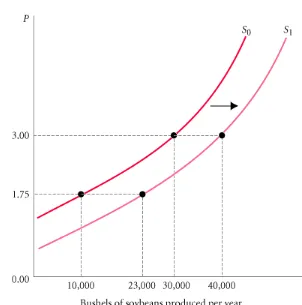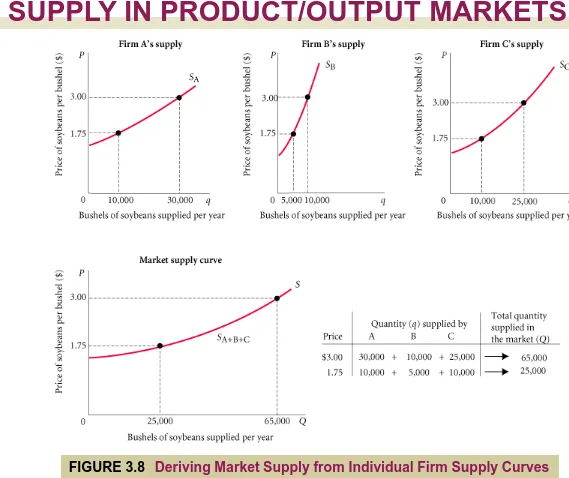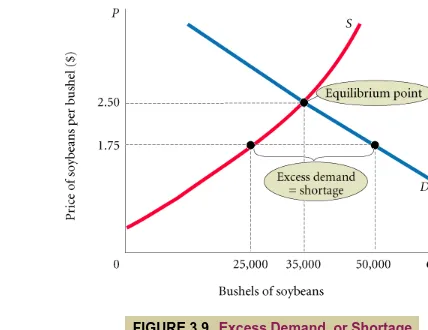© 2007 Prentice Hall Business Publishing Principles of Economics 8e by Case and Fair
Prepared by:
Fernando & Yvonn Quijano
3
Chapter
Demand, Supply,
R
brium Chapter Outline
3
Demand, Supply,
and Market Equilibrium
Firms and Households:
The Basic Decision-Making Units Input Markets and Output Markets: The Circular Flow
Demand in Product/Output Markets
Changes in Quantity Demanded versus Changes in Demand
Price and Quantity Demanded: The Law of Demand Other Determinants of Household Demand
Shift of Demand versus Movement along a Demand Curve
From Household Demand to Market Demand
Supply in Product/Output Markets
Price and Quantity Supplied: The Law of Supply Other Determinants of Supply
Shift of Supply versus Movement along a Supply Curve
From Individual Supply to Market Supply
CHAPTE
© 2007 Prentice Hall Business Publishing Principles of Economics 8e by Case and Fair 3 of 46
FIRMS AND HOUSEHOLDS:
THE BASIC DECISION-MAKING UNITS
firm An organization that transforms
resources (inputs) into products (outputs). Firms are the primary
producing units in a market economy.
entrepreneur A person who organizes, manages, and assumes the risks of a firm, taking a new idea or a new product and turning it into a successful business.
R
3:
Demand,
Supply
,
and
Ma
rket
Equi
li
brium
INPUT MARKETS AND OUTPUT MARKETS:
THE CIRCULAR FLOW
product or output markets The
markets in which goods and services are exchanged.
input or factor markets The markets in which the resources used to produce
CHAPTE
R
3:
Demand,
Supply
,
and
Ma
rket
Equi
li
brium
© 2007 Prentice Hall Business Publishing Principles of Economics 8e by Case and Fair 5 of 46
INPUT MARKETS AND OUTPUT MARKETS:
THE CIRCULAR FLOW
R
3:
Demand,
Supply
,
and
Ma
rket
Equi
li
brium
INPUT MARKETS AND OUTPUT MARKETS:
THE CIRCULAR FLOW
labor market The input/factor market in which households supply work for wages to firms that demand labor.
capital market The input/factor market in which households supply their
savings, for interest or for claims to
CHAPTE
© 2007 Prentice Hall Business Publishing Principles of Economics 8e by Case and Fair 7 of 46
INPUT MARKETS AND OUTPUT MARKETS:
THE CIRCULAR FLOW
land market The input/factor market in which households supply land or other real property in exchange for rent.
factors of production The inputs into the production process. Land, labor, and capital are the three key factors of
production.
Input and output markets are connected through the behavior of both firms and households. Firms determine the quantities and character of outputs produced and the types of
R
DEMAND IN PRODUCT/OUTPUT MARKETS
A household’s decision about what quantity of a
particular output, or product, to demand depends on a number of factors including:
■ The price of the product in question
■ The income available to the household
■ The household’s amount of accumulated wealth
■ The prices of other products available to the household
■ The household’s tastes and preferences
CHAPTE
R
3:
Demand,
Supply
,
and
Ma
rket
Equi
li
brium
© 2007 Prentice Hall Business Publishing Principles of Economics 8e by Case and Fair 9 of 46
DEMAND IN PRODUCT/OUTPUT MARKETS
quantity demanded The amount (number of units) of a product that a
R
3:
Demand,
Supply
,
and
Ma
rket
Equi
li
brium
DEMAND IN PRODUCT/OUTPUT MARKETS
The most important relationship in individual markets is that between
market price and quantity demanded.
CHAPTE
© 2007 Prentice Hall Business Publishing Principles of Economics 8e by Case and Fair 11 of 46
DEMAND IN PRODUCT/OUTPUT MARKETS
PRICE AND QUANTITY DEMANDED: THE LAW OF DEMAND
demand schedule A table showing how much of a given
product a household would be willing to buy at different
prices.
TABLE 3.1 Anna’s Demand Schedule for Telephone Calls
PRICE (PER CALL)
QUANTITY DEMANDED (CALLS PER MONTH)
R
3:
Demand,
Supply
,
and
Ma
rket
Equi
li
brium
DEMAND IN PRODUCT/OUTPUT MARKETS
demand curve A graph illustrating how much of a given product a household
would be willing to buy at different prices.
CHAPTE
© 2007 Prentice Hall Business Publishing Principles of Economics 8e by Case and Fair 13 of 46
DEMAND IN PRODUCT/OUTPUT MARKETS
law of demand The negative
relationship between price and quantity demanded: As price rises, quantity
demanded decreases. As price falls, quantity demanded increases.
Demand Curves Slope Downward
R
3:
Demand,
Supply
,
and
Ma
rket
Equi
li
brium
DEMAND IN PRODUCT/OUTPUT MARKETS
Other Properties of Demand Curves
As long as households have limited incomes and wealth, all demand curves will intersect the price axis. For any commodity, there is always a price above which a household
will not, or cannot, pay. Even if the good or service is very important, all households are ultimately constrained, or limited, by income and wealth.
That demand curves intersect the quantity axis is a matter of common sense. Demand in a given period of time is limited, if only by time, even at a zero price.
Two additional things are notable about
CHAPTE
© 2007 Prentice Hall Business Publishing Principles of Economics 8e by Case and Fair 15 of 46
DEMAND IN PRODUCT/OUTPUT MARKETS
To summarize what we know about the shape of demand curves:
1. They have a negative slope. An increase in price is likely to lead to a decrease in
quantity demanded, and a decrease in price is likely to lead to an increase in quantity
demanded.
2. They intersect the quantity (X-) axis, a result of time limitations and diminishing marginal utility.
R
3:
Demand,
Supply
,
and
Ma
rket
Equi
li
brium
DEMAND IN PRODUCT/OUTPUT MARKETS
OTHER DETERMINANTS OF HOUSEHOLD DEMAND
income The sum of all a household’s
wages, salaries, profits, interest payments, rents, and other forms of earnings in a
given period of time. It is a flow measure.
Income and Wealth
CHAPTE
R
3:
Demand,
Supply
,
and
Ma
rket
Equi
li
brium
© 2007 Prentice Hall Business Publishing Principles of Economics 8e by Case and Fair 17 of 46
DEMAND IN PRODUCT/OUTPUT MARKETS
normal goods Goods for which demand goes up when income is higher and for which demand goes down when income is lower.
R
3:
Demand,
Supply
,
and
Ma
rket
Equi
li
brium
DEMAND IN PRODUCT/OUTPUT MARKETS
Prices of Other Goods and Services
substitutes Goods that can serve as replacements for one another: when the price of one increases, demand for the other goes up.
perfect substitutes Identical products.
complements, complementary goods
Goods that “go together”: a decrease in
CHAPTE
R
3:
Demand,
Supply
,
and
Ma
rket
Equi
li
brium
© 2007 Prentice Hall Business Publishing Principles of Economics 8e by Case and Fair 19 of 46
DEMAND IN PRODUCT/OUTPUT MARKETS
Tastes and Preferences
Perfect substitutes? On a hot day in the desert, one brand is as good as another.
R
DEMAND IN PRODUCT/OUTPUT MARKETS
SHIFT OF DEMAND VERSUS MOVEMENT ALONG A DEMAND CURVE
TABLE 3.2 Shift of Anna’s Demand Schedule Due to increase in Income
SCHEDULE D0 SCHEDULE D1
Price (Per Call)
Quantity Demanded (Calls Per Month
at an Income of $300 Per Month)
Quantity Demanded (Calls Per Month
CHAPTE
© 2007 Prentice Hall Business Publishing Principles of Economics 8e by Case and Fair 21 of 46
DEMAND IN PRODUCT/OUTPUT MARKETS
shift of a demand curve The change that takes place in a demand curve corresponding to a new relationship between quantity
demanded of a good and price of that good. The shift is brought about by a change in the original conditions.
movement along a demand curve The change in quantity demanded brought about by a change in price.
Change in price of a good or service leads to
Change in quantity demanded (movement along the demand curve).
Change in income, preferences, or prices of other goods or services leads to
R
3:
Demand,
Supply
,
and
Ma
rket
Equi
li
brium
CHAPTE
R
3:
Demand,
Supply
,
and
Ma
rket
Equi
li
brium
© 2007 Prentice Hall Business Publishing Principles of Economics 8e by Case and Fair 23 of 46
DEMAND IN PRODUCT/OUTPUT MARKETS
FROM HOUSEHOLD DEMAND TO MARKET DEMAND
market demand The sum of all the
R
3:
Demand,
Supply
,
and
Ma
rket
Equi
li
brium
CHAPTE
R
3:
Demand,
Supply
,
and
Ma
rket
Equi
li
brium
© 2007 Prentice Hall Business Publishing Principles of Economics 8e by Case and Fair 25 of 46
SUPPLY IN PRODUCT/OUTPUT MARKETS
profit The difference between revenues and costs.
R
3:
Demand,
Supply
,
and
Ma
rket
Equi
li
brium
SUPPLY IN PRODUCT/OUTPUT MARKETS
PRICE AND QUANTITY SUPPLIED: THE LAW OF SUPPLY
quantity supplied The amount of a particular product that a firm would be willing and able to offer for sale at a
CHAPTE
© 2007 Prentice Hall Business Publishing Principles of Economics 8e by Case and Fair 27 of 46
SUPPLY IN PRODUCT/OUTPUT MARKETS
TABLE 3.3 Clarence Brown’s Supply Schedule for Soybeans
PRICE (PER BUSHEL)
QUANTITY SUPPLIED (BUSHELS PER MONTH)
$1.50 0
supply schedule A table showing how
R
3:
Demand,
Supply
,
and
Ma
rket
Equi
li
brium
SUPPLY IN PRODUCT/OUTPUT MARKETS
law of supply The positive relationship between price and quantity of a good
CHAPTE
R
3:
Demand,
Supply
,
and
Ma
rket
Equi
li
brium
© 2007 Prentice Hall Business Publishing Principles of Economics 8e by Case and Fair 29 of 46
SUPPLY IN PRODUCT/OUTPUT MARKETS
supply curve A graph illustrating how much of a product a firm will sell at
different prices.
FIGURE 3.6 Clarence Brown’s
R
3:
Demand,
Supply
,
and
Ma
rket
Equi
li
brium
SUPPLY IN PRODUCT/OUTPUT MARKETS
OTHER DETERMINANTS OF SUPPLY
The Cost of Production
Regardless of the price that a firm can command for its product, revenue must
CHAPTE
© 2007 Prentice Hall Business Publishing Principles of Economics 8e by Case and Fair 31 of 46
SUPPLY IN PRODUCT/OUTPUT MARKETS
The Prices of Related Products
A soybean farm is a producer that supplies soybeans to the market.
Assuming that its objective is to maximize profits, a firm’s decision about what quantity
of output, or product, to supply depends on 1. The price of the good or service
2. The cost of producing the product, which in turn depends on
■ The price of required inputs (labor, capital, and land)
R
3:
Demand,
Supply
,
and
Ma
rket
Equi
li
brium
SUPPLY IN PRODUCT/OUTPUT MARKETS
SHIFT OF SUPPLY VERSUS MOVEMENT ALONG A SUPPLY CURVE
movement along a supply curve The change in quantity supplied brought about by a change in price.
shift of a supply curve The change that takes place in a supply curve corresponding to a new relationship between quantity
CHAPTE
© 2007 Prentice Hall Business Publishing Principles of Economics 8e by Case and Fair 33 of 46
SUPPLY IN PRODUCT/OUTPUT MARKETS
TABLE 3.4 Shift of Supply Schedule for Soybeans Following Development of a New Disease-Resistant Seed Strain
SCHEDULE D0 SCHEDULE D1
Price (Per Bushel)
Quantity Supplied (Bushels Per Year Using Old Seed)
Quantity Supplied (Bushels Per Year Using New Seed)
$1.50 0 5,000
R
3:
Demand,
Supply
,
and
Ma
rket
Equi
li
brium
SUPPLY IN PRODUCT/OUTPUT MARKETS
Change in price of a good or service leads to
Change in quantity supplied (movement along a supply curve).
Change in income, preferences, or prices of other goods or services leads to
Change in supply (shift of a supply curve).
As with demand, it is very important to
distinguish between movements along supply curves (changes in quantity supplied) and
CHAPTE
R
3:
Demand,
Supply
,
and
Ma
rket
Equi
li
brium
© 2007 Prentice Hall Business Publishing Principles of Economics 8e by Case and Fair 35 of 46
SUPPLY IN PRODUCT/OUTPUT MARKETS
FROM INDIVIDUAL SUPPLY TO MARKET SUPPLY
market supply The sum of all that is
R
3:
Demand,
Supply
,
and
Ma
rket
Equi
li
brium
CHAPTE
R
3:
Demand,
Supply
,
and
Ma
rket
Equi
li
brium
© 2007 Prentice Hall Business Publishing Principles of Economics 8e by Case and Fair 37 of 46
MARKET EQUILIBRIUM
equilibrium The condition that exists when quantity supplied and quantity
R
3:
Demand,
Supply
,
and
Ma
rket
Equi
li
brium
MARKET EQUILIBRIUM
EXCESS DEMAND
excess demand or shortage The condition that exists when quantity demanded exceeds quantity supplied at the current price.
CHAPTE
R
3:
Demand,
Supply
,
and
Ma
rket
Equi
li
brium
© 2007 Prentice Hall Business Publishing Principles of Economics 8e by Case and Fair 39 of 46
MARKET EQUILIBRIUM
FIGURE 3.9 Excess Demand, or Shortage
R
3:
Demand,
Supply
,
and
Ma
rket
Equi
li
brium
MARKET EQUILIBRIUM
EXCESS SUPPLY
CHAPTE
R
3:
Demand,
Supply
,
and
Ma
rket
Equi
li
brium
© 2007 Prentice Hall Business Publishing Principles of Economics 8e by Case and Fair 41 of 46
MARKET EQUILIBRIUM
FIGURE 3.10 Excess Supply, or Surplus
When quantity supplied exceeds quantity demanded at the current price, the price tends to fall. When price falls, quantity supplied is likely to decrease and quantity demanded is likely to increase until an equilibrium price is reached where quantity supplied and quantity
R
3:
Demand,
Supply
,
and
Ma
rket
Equi
li
brium
MARKET EQUILIBRIUM
CHANGES IN EQUILIBRIUM
When supply and demand curves shift, the equilibrium price and quantity change.
CHAPTE
R
3:
Demand,
Supply
,
and
Ma
rket
Equi
li
brium
© 2007 Prentice Hall Business Publishing Principles of Economics 8e by Case and Fair 43 of 46
MARKET EQUILIBRIUM
R
DEMAND AND SUPPLY IN PRODUCT MARKETS:
A REVIEW
1. A demand curve shows how much of a product a household would buy if it could buy all it wanted at the given price. A supply curve shows how much of a product a firm would supply if it could sell all it wanted at the given price.
2. Quantity demanded and quantity supplied are always per time period—that is, per day, per month, or per year.
3. The demand for a good is determined by price, household income and wealth, prices of other goods and services, tastes and preferences, and expectations.
4. The supply of a good is determined by price, costs of production, and prices of related products. Costs of production are determined by available technologies of production and input prices.
5. Be careful to distinguish between movements along supply and demand curves and shifts of these curves. When the price of a good changes, the quantity of that good demanded or supplied changes—that is, a movement occurs along the curve. When
CHAPTE
© 2007 Prentice Hall Business Publishing Principles of Economics 8e by Case and Fair 45 of 46
LOOKING AHEAD: MARKETS AND THE
ALLOCATION OF RESOURCES
You can already begin to see how markets answer the basic economic questions of what is produced, how it is produced, and who gets what is produced.
■ Demand curves reflect what people are
willing and able to pay for products; they are influenced by incomes, wealth, preferences, prices of other goods, and expectations.
■ Firms in business to make a profit have a good reason to choose the best available technology—lower costs mean higher profits.
R
excess demand or shortage excess supply or surplus factors of production firm
households income
inferior goods
input or factor markets
law of supply market demand market supply
movement along a demand curve movement along a supply curve normal goods
perfect substitutes
product or output markets profit
quantity demanded quantity supplied
shift of a demand curve shift of a supply curve substitutes
supply curve
